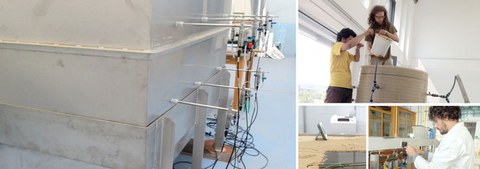INOWAS-lab
The focus of our lab-scale investigations lies on the generation of new qualitative and quantitative insights on the functionality of MAR schemes. For this, we make use of custom-designed physical models to simulate different site-specific and process-related conditions. The specific objectives include:
- Studies on sensitivity of boundary conditions in the experimental setup
Asessing the reliability of experimental setup at laboratory and pilot scale for the simulation of naturally-occurring environments (overarching topic with MAR-PILOT research field). - Investigations on quantity/quality trade-off conditions for clogging avoidance
Understanding the combined influence of operational parameters, water quality and soil characteristics on the reduction of infiltration capacity in surface infiltration systems due to clogging. - Development of methods for clogging quantitative assessment
Contributions to the development of suitable techniques for quantitative characterisation of clogging processes during MAR operation.

INOWAS-LAB collage
Read more
-
Sallwey, J., Barquero, F., Fichtner, T., Stefan, C. (2019) Planning MAR schemes using physical models: comparison of laboratory and field experiments. Applied Sciences, 9(18): 3652. https://doi.org/10.3390/app9183652.
-
Fichtner, T., Barquero, F., Sallwey, J., Stefan, C. (2019) Assessing Managed Aquifer Recharge Processes under Three Physical Model Concepts. Water, 11(1): 107. https://doi.org/10.3390/w11010107.
-
Fichtner, T., Goersmeyer, N., Stefan, C. (2019) Influence of Soil Pore System Properties on the Degradation Rates of Organic Substances during Soil Aquifer Treatment (SAT). Applied Sciences, 9(3), 496. https://doi.org/10.3390/app9030496.
-
Vígolo Coutinho, J., das Neves Almeida, C., da Silva, E.B., Stefan, C., Barbosa Athayde Júnior, G., Moreira Gadelha, C.L., Walter, F. (2018) Managed aquifer recharge: study of undisturbed soil column tests on the infiltration and treatment capacity using effluent of wastewater stabilization pond. Brazilian Journal of Water Resources, v.23, e50. https://doi.org/10.1590/2318-0331.231820180060.
